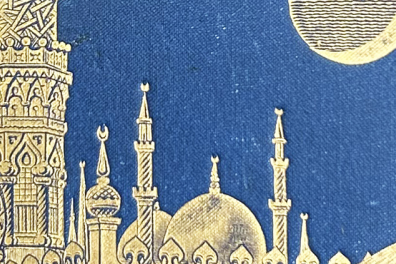International symposium "Metamorphoses of the "Thousand and One Nights" from Baghdad to Versailles and beyond. From the mirror of princes to the cultural object", April 19-21

Colloquium organized by the Centre de Recherches Moyen-Orient Méditerranée (CERMOM, Inalco), the Centre d'histoire culturelle des sociétés contemporaines (CHCSC, Université de Versailles Saint-Quentin-en-Yvelines), the Graduate School Humanités - Sciences du Patrimoine (HSP, Université Paris-Saclay), and the Université Paris III - Sorbonne nouvelle.
With the support of the Inalco Scientific Council.
From Wednesday, April 19 to Friday, April 21, 2023
Wednesday, April 19 and Thursday, April 20, 2023 - at the Bibliothèque centrale de Versailles
5, rue de l'Indépendance américaine - 78000 Versailles
Friday, April 21 - at the Maison de la recherche de l'Inalco
2, rue de Lille - 75007 Paris
Free admission.
Historically, Les Mille et Une Nuits were not always Les Mille et Une Nuits. In fact, they very quickly ceased to be so as a textual object, becoming a multilingual, multi-media cultural object as soon as they entered modernity and, above all, since the media revolution (Musawi 2021; Hiddleston and Ouyang 2021; Marzolph 2019; Stead 2011, etc.). Their birth, in the Arab world, in Baghdad, is not a creation but, already the metamorphosis of a venerable Persian work, the Hazâr afsân or Thousand Tales intended for the education of princes, rearranged, reinvested, transformed, and suddenly becoming with new material Alf layla wa-layla, The Thousand and One Nights. And as if to continue swarming other possible texts, and other content, it also becomes The Hundred and One Nights, as well as hundreds of works in the same genre whose full extent has yet to be realized, such as the Livre des histoires étonnantes et des anecdotes surprenantes : works in which, as their name doesn't suggest, politics, commerce, the art of living, but also the art of educating and influencing, play a major role (Chraïbi 2015).
Since their adaptation into French by Antoine Galland and the additions due to the young Syrian Hannâ Diyâb (Akel 2017) at the very beginning of the 18th century in the context of the court of Versailles, since the literary vogue for fairy tales and their dazzling recognition, Les Mille et Une Nuits have not ceased to transform and swarm again, on a larger scale, and at an altogether different speed, in contact with numerous languages and cultures which, in turn, have transformed and fertilized them. Known the world over today through editions, exhibitions, cinema, the internet, video and games, and easily lending themselves to the global dimension of literary studies, they now find themselves somewhat cramped in the literary context, their cultural aura having surpassed their textual existence (Akel and Granara 2020). The Thousand and One Nights have indeed taken over all media, from books to albums to comics, and all genres, from storytelling to novels, theater, poetry, ballet, pantomime and cinema, and far beyond, including advertising, clothing fashion, design, furniture and the decorative arts. The encyclopedia devoted to them is there to bear witness (Marzolph and Van Leeuwen 2004). The Nights are no longer just a text, but a myth, a fertile, plastic material that continues to inspire.
The Nights found their first European readers among the ladies of the Versailles court. Close to this site and from the historic headquarters of the École des langues orientales, this international and multidisciplinary colloquium intends to examine pivotal moments in such reinterpretations, starting with the Baghdad legacy and its disseminations, continuing through the Parisian era of Antoine Galland and Hannâ Diyâb, and extending into the 20th and 21st centuries.
Open to specialists from different backgrounds, it aims to explore modes of reception, assimilation, stylization and use of the medieval masterpiece from the tales that mark its origins, to today's cultural history (Elmaz 2020). The symposium will seek to identify major cultural concepts at work:
- in treatments, rewritings and uses of tales in their pre-modern and modern disseminations;
- in illustrated books, advertisements and decorative arts;
- in performance and entertainment arts;
- in cinema and television, in comic strips and the internet;
- in fashion and social uses of the Nights;
- in cultural stratification.
Organization
Evanghelia STEAD (Université de Versailles Saint-Quentin-en-Yvelines, CHCSC, CERMOM)
Ibrahim AKEL (Sorbonne nouvelle, CERMOM)
Aboubakr CHRAIBI (Inalco, CERMOM)
Contacts
View e-mail ; View e-mail and View e-mail